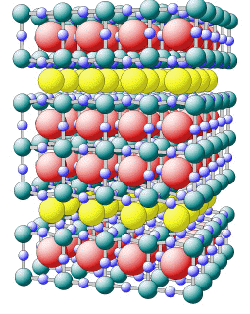Superconductors Show Their Stripes

Like tigers and zebras, high-temperature superconductors appear to be curious beasts, distinguished by their stripes. Some physicists believe that electricity runs without resistance along lines, or “stripes,” of electric charge in these materials. That controversial theory gets a big boost now that a team has finally observed these stripes in the most widely studied of the so-called cuprate superconductors, as reported in the 4 March print issue of PRL. The researchers’ large crystal sample enabled them to detect new details in neutron scattering data that support the notion that you can’t separate a cuprate superconductor from its stripes.
The cuprate superconductors are something like multi-tiered dance halls for electric charges. They consist of parallel planes of copper and oxygen atoms. Within each plane the copper atoms arrange themselves in a square grid, with an oxygen atom sitting between each pair of neighboring coppers. Between the planes lie atoms of other elements, and some of these absorb electrons from the copper atoms, leaving positively charged “holes” behind. Researchers know that these holes pair up to waltz without resistance along the planes. However, they aren’t sure how the like-charged holes manage to cling together.
Some believe that the holes first form long stripes in which it is easier to move through the copper-oxygen terrain. A hole masks the magnetism of the copper atom on which it sits. So as an isolated hole jumps from one copper atom to the next, it appears as if the copper’s magnetism is jumping in the opposite direction. But such hopping requires lots of energy because it disrupts the coppers’ usual up-down-up-down pattern of magnetic fields. However, if many holes settle on a long stripe of several copper-oxygen rows, they form a runway along which there is no magnetism and no field pattern to disrupt. The holes still repel each other, but they don’t wander from the stripe because it costs less energy to stay together and even to form pairs, which can glide along the runway without losing energy.
Or so the theory goes. Unfortunately for proponents of this scenario, charge stripes had been directly observed in only one high-temperature superconductor, lanthanum strontium copper oxide, and even then researchers had to add some impurities to hold the stripes still. But now Herb Mook and his colleagues at Oak Ridge National Laboratory in Tennessee have spotted charge stripes in yttrium barium copper oxide (YBCO) without impurities.
The researchers used a neutron beam to probe the atomic structure of a 25-gram crystal of YBCO. With such a large chunk, they were able to look for more subtle features than just the placement of the atoms in the crystal. Indeed, they observed a faint signal in the scattered neutrons that showed there was a stripe of holes along every eighth row of the copper-and-oxygen planes.
The results strengthen the case for a connection between high-temperature superconductivity and stripes, says Steven Kivelson of the University of California, Los Angeles, an originator of the stripes theory. “It begins to establish the case that these are both parts of the same problem,” he says. Douglas Scalapino of the University of California, Santa Barbara, agrees but has more questions. “Are these two phases of the material competing against each other,” Scalapino wonders, “or is it possible that there is this terrific synergy between stripes and superconductivity?”
–Adrian Cho
Adrian Cho is a freelance science writer in Grosse Pointe Woods, Michigan.
More Information
In an upcoming paper in PRL, another team reports evidence for stripes in YBCO. Another team has recently seen stripes in the Bi/Sr/Ca cuprate superconductor.


